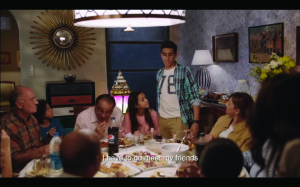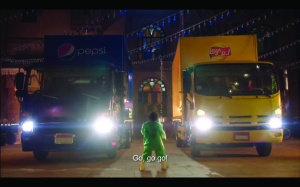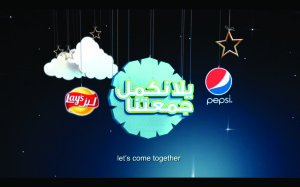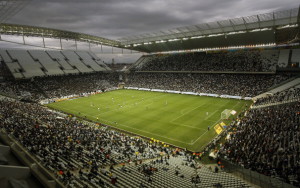Last year, Pepsi’s three-minute “Let’s Come Together” film for Ramadan was not only among the longest ads released in the Middle East for the Holy Month – with, presumably, a budget to match – but also the most watched video on YouTube outside of and in the MENA region, having clocked up close to five million views. Its viral effect was hardly by chance and absolutely by choice. “On digital platforms, our only objective was to maximize the viewership of the TVC; we amplified it on social [media] and worked with a number of influencers in the region for this purpose,” says Waseem Afzal, head of digital at OMD Dubai, which handles the media account for Pepsi. But this year, Pepsi, a World Cup non-sponsor – but great supporter, as its incessant football ad campaigns have shown – might just be competing against itself for online attention during Ramadan, which, for a ten-day period between June 28 and July 13, will be overlapping with the one-month championship.
Religious Following
“The World Cup takes place every four years, as a result of which brands have to be very careful around their digital footprints [during Ramadan]. Not all brands are chasing Ramadan as a standalone flagship event of the year and many of them are trying to blur their communication platforms between Ramadan and the World Cup. [For us], while there will be a focus on the amplification of video content, there’s also a big social element to it,” he explains, adding that, while, historically, the life cycle of a football enthusiast’s excitement would end with that of a match, “now it’s about previews, reviews and controversy [around the games]”.
In a region where both Ramadan traditions and football are deeply ingrained in the social and cultural fabric, the ten-day overlap begs the question as to which out of two will own content creation and consumption, media choices and client budgets. In a study that canvassed five MENA countries (Saudi Arabia, Egypt, Morocco, the UAE and Algeria), entitled: The Big Match: Ramadan vs Football World Cup 2014, Starcom Mediavest Group (SMG) MENA’s research and analysis company, Business Compass, answered this very question. With peak times for both flagship Ramadan TV programs and World Cup matches scheduled between 7pm and 11pm, the research shows that, on average, 66 percent of men and 34 percent of women choose to watch the World Cup over Ramadan series. Moreover, 62 percent of men will watch the first after-iftar World Cup game of the night live, during which Ramadan series’ viewership – mostly women – is likely to be redirected to catch-up video-on-demand platforms, such as MBC’s Shahid.net.
Double Up
Even more tellingly, in households, men feel more confident in “getting control of the remote” during World Cup matches, with 23 percent believing that their choice of programming will overrule that of others, when compared with 12 percent of women that will, nonetheless, continue to drive Ramadan content consumption, with 80 percent following their regular TV programs – which are overwhelmingly Ramadan series.
Although its global guidelines dictate it to steer clear from religious content association, “Pepsi will still have a Ramadan campaign. Brands are wary of the fact that they operate in a region where the Holy Month is deep-rooted in its culture and traditions,” explains Afzal.
Hussein Freijeh, managing director at Yahoo! Middle East and Africa, says the growth of the TV industry in the MENA region over the past three years, “whereby TV channels across the region have upped their Ramadan grids and offerings, which were once overtaken by one network”, coupled with great infrastructural leaps for online consumption, will allow for the amplification of people’s media behavior across platforms and screens, rather than hinder it on one or the other. “One of the key differentiators between this region and others is that the more people consume TV, the more they do the same online. The overlap between Ramadan and the World Cup will only magnify people’s abilities and willingness to engage with media, because they will have more free time on their hands,” says Freijeh, while Alfonso De Gaetano, head of branding at Google MENA, adds that, indeed, the time period whereby clients will want “to leverage both their World Cup and Ramadan activations will generate the biggest source of revenue for us since we launched here [in the MENA region]. To be honest, Ramadan, for us, will be bigger in the region, because the live part of the World Cup is its key attraction”, whereas YouTube would serve better for catch-up, replay and highlights activities.
High Mobility
While, historically, content was associated with traditional Arabic providers during the Holy Month, Ramadan coinciding with the World Cup translates into a user behavioral shift to social and mobile platforms, “because a lot of football games will kick off quite late into the night. This will push user consumption on the go,” explains Afzal. In fact, “the Internet has made my life easier and more convenient during Ramadan” was a highly agreeable attitudinal statement by a majority of respondents (83 percent) in Yahoo!’s 2013 Ramadan Consumer Survey. This year will be no exception, with Yahoo! revealing that video content and mobile will fuel the double experience of people going online to watch recaps and replays of Ramadan TV programs, as well as World Cup highlights, commentary and analysis. “One of the lowest-hanging fruits, however under-utilized, opportunities on Facebook for advertisers globally, but, here, in particular, is video [advertising],” says Jonathan Labin, head of Facebook for Middle East, Africa and Pakistan. The same applies to mobile, for which the Internet usage penetration stands at 68 percent in the KSA and 72 percent in the UAE, as per Yahoo!’s figures.
According to another 2013 study by SMG MENA, entitled: The Ramadan Multiplier Effect, during the Holy Month, a peak in mobile consumption was noticeable in the wee hours of mornings, between 3am and 6am, “when they [fasting users] wake up for suhoors [pre-dawn meals]. Browsing on mobile increases by 13 percent in the KSA during Ramadan,” says Ali Nehme, managing director of digital at SMG MENA, adding that this number spikes during TV peak times in both the UAE and the KSA, both of which witness increases in browsing visits through mobile of 51 percent and 28 percent, respectively. In fact, Nehme and his team are recommending mobile-first and heavy activations for Ramadan. “For the first time, we are going to integrate a brand within a mobile experience through our [bespoke World Cup football] app and our content productions,” says Freijeh, adding that five of Yahoo!’s seven sponsors for the World Cup have opted for the publisher’s integrated solutions.
Social Experiments
Naturally, the increased use of mobile translates into active social media consumption during Ramadan, when, as per SMG MENA’s studies, more than two thirds of traffic to the region’s largest social platforms – 68 percent on Facebook and 76 percent on Twitter – are generated through mobile devices, with 68 percent of YouTube homepage traffic coming from mobile browsers. On average, “you’ll see a 20 percent increase in engagement [during the Holy Month] compared with other periods of the year with everything social and you’ll see higher CTRs (click-through rates). This is probably because people have nothing to do and are bored. They want to waste time and they are more prone to clicking on ads,” explains Nehme. In fact, for women in the region, SMG MENA has found that 29 percent of Ramadan information and updates come from Facebook, 14 percent from Twitter and 12 percent from YouTube.
“We’ve found that social media owners are able to show us their reach by providing granular data on viewers,” says Mohammed Ali Faruqi, media and digital manager for the Arabian Peninsula at Procter & Gamble (P&G). P&G recently signed a deal with Google across key markets in the region, including Saudi Arabia, the UAE, Kuwait, Qatar, Bahrain and Oman, as well as Egypt and Morocco, which entails the creation of a YouTube Ramadan hub sponsored by P&G, “as well as You- Tube mastheads on key dates during Ramadan. During previous [Ramadan] seasons, our spending has been pretty much limited to TV, where we’ve sponsored popular series and advertised during ad breaks and leveraged other spots during peak hours,” Faruqi points out.
No charity money
Looking at 2,106 campaigns in the UAE and 1,626 in the KSA released during Ramadan 2013, SMG MENA found that the former saw an uplift of 1.3 percent in digital campaigns and the latter of 6.5 percent, when compared with the previous year. “Telcos in the KSA are the most active before and during Ramadan, and so are food brands. Toward the end of the [Holy] Month, you’ll see all automotive brands communicating around offers and promotions. Otherwise, not many brands know how to utilize this month,” says Nehme. In fact, SMG MENA found campaigns during the Holy Month to tackle, in majority, generic messages, followed by offers and promotions, then Ramadan-specific initiatives and, lastly, social media competitions; “all using Ramadan traffic to deliver non-Ramadan advertising copies”.
For its World Cup offering – which, this year, happens to be one and the same with Ramadan, Yahoo! MEA secured seven sponsors: Pepsi, General Motors, Etisalat, Samsung, Qatari telco operator Ooreedoo (previously Qtel) and Nivea. “The offering ranges from associating with the World Cup to having those brands be part of our World Cup experience, all the way to integrating products and brands within that experience,” explains Freijeh. At least in size, De Gaetano says that, this year, YouTube’s mega-deal with P&G is unmatched by other advertisers on the platform, which include automotive, technology, FMCG, personal care and home care brands. “We probably see similar trends like the rest of the industry does; FMCGs are some of the most active players and, at the end of Ramadan, some of the automotive brands come in stronger,” adds Labin. “From a user’s perspective, we’re not really competing; people are consuming content across the board. From a revenue perspective, of course, we are. And we just need to show how relevant we are for the brand. Our positioning is that we are a digital, relevant and personalized content publisher,” says Freijieh.
Disparates Measures
Indeed, social networks in the region have been noticeably advertising their USPs over the past two months, with Facebook recently partnering with Ipsos for an infographic showing that the network is a “constant companion” for 48 million mobile users in the MENA region during Ramadan and is accessed by 77 percent of monthly users in Egypt, the KSA and the UAE during TV primetime. Labin highlights four key propositions for the social network that would serve well during Ramadan; “personalized marketing at scale with a great creative canvas; daytime targeting, whereby an advertiser could target followers of a specific TV show during different times of the day with different messaging; newsfeed advertising, which we introduced a little over a year ago; and, Custom Audiences, a tool that allows clients to pay for a target group based on their own databases, out of which they create matches and clusters of similar audiences” – much like Google’s Similar Audiences.
The multi-platform activity was equally fueled by multi-screen behavior in the region over the past two years, says Afzal, adding that: “While, historically, content has been associated with TV in the region, the rise of YouTube and Shahid.net has premium content cascading onto digital screens.” With the consumption of religious content during Ramadan spiking up and no category leader in sight, long-tail sites, such as global and regional forums, might be attracting audiences and crowd-sourced content, but not necessarily brands. “Over the past twelve months, there has been a vivid shift from brands focusing on forums to associating themselves with chatter on social platforms, or they would rather become part of content platforms, as the rise of native advertising continues,” he explains.
King’s Fort
“Multi-tasking is a key component in the way we look at media consumption. The industry is opening up; we realize that we are complementing each other,” Freijieh points out. That may well be the case for digital players, but not for TV broadcasters, to whom Ramadan is still, inarguably, the biggest revenue generator for the year. And, in this regard, they have grown more protective of their content; successfully so, it seems, as SMG MENA’s studies show that, while social media activity increases by 55 percent in the KSA and 49 percent in the UAE during TV peak times, most of the online video catch-up activity is happening on MBC’s Shahid.net, which has grown to compete with social networks and video platforms the broadcaster had once partnered with – when it used to make some parts of its hit shows available to Yahoo! and YouTube.
“With regards to our relationship with MBC and other content partners, it’s really up to them. We are a platform. We don’t own any content, we allow them to monetize it. Sometimes they add content and sometimes they don’t,” says De Gaetano. Likewise, Labin stresses on Facebook’s openness as a platform, despite the fact that the network has not secured content partnerships with regional broadcasters. “We are partnering in the US with some broadcasters, but more along the lines of integrating insights from Facebook into their programming,” he clarifies.
“The inherent needs of consumers in the region are to be entertained. Ramadan has not become digital just yet. TV is rooted in the Holy Month’s customs; it’s part of the culture and part of the legacy that big-ticket programs come on the big screen,” says Afzal. And, while De Gaetano concurs, he believes YouTube’s strength lies in providing global, not Ramadan content, during Ramadan. “The P&G package has no TV content in it and it’s the biggest we’ve sold since we launched in the MENA region,” he adds.
In fact, YouTube is being leveraged as a TV-plus media solution in the region, as it transpired in six recent cross-media studies the platform conducted with global research company Millward Brown in Saudi Arabia and across large advertisers, such as P&G, Unilever, Mars and Mondelez. The study showed that YouTube brings nearly eight percent of incremental reach to TV, is 66 percent more efficient than TV when comparing cost-per-reach points – with less than 10 percent of TV budget, on average – and accounts for 34 percent of measured improvement in advertisers’ key brand metrics. Taking these numbers into account, De Gaetano says: “The question is, how do you combine different TV channels with YouTube in an efficient way to maximize reach and reduce costs?”
Customary Customization
For YouTube, the answer is in devising sponsorship packages for the Holy Month that are similar to TV’s, even if for completely different advertising solutions and targeting capabilities – such as skippable ads and frequency caps. “What we are offering that is very traditional is really content ownership. It is the same thing that advertisers are used to doing on TV. Why? Because other options are not available to them,” explains De Gaetano, referring to YouTube’s previous partnership with Unilever, where the multinational sponsored all long-form Arabic content on the platform during the Ramadan season for two years and, this year, with Pepsi, whereby the brand will buy all of its regional music inventory across the year; not to mention P&G, which will be sponsoring 20 to 40 channels under each of YouTube’s TV shows under comedy, lifestyle and cooking categories for Ramadan. Nehme says MBC has been offering sponsorships of its Ramadan series on online extensions, such as its website. “In this case, online ads are not being sold on a CPM (cost per 1,000) measure. At least not on the surface,” he says. Over the past two years, SMG MENA’s online recommendations for advertisers during Ramadan have been largely driven by sponsorship packages for content sections.
When asked about the price movement during Ramadan, online publishers unanimously agree that it depends, as it would any other time of the year, on usage numbers. “On biddable marketplaces, such as Facebook, YouTube and Twitter, prices would go up [during Ramadan], if only for the fact that usage goes up,” says De Gaetano, while Freijeh adds: “Sponsorships are not differently priced for Ramadan; they can be more expensive because there are more people visiting [online]. But, the CPR (cost per reach) doesn’t increase during this month. Even if on a flat basis, the sponsorship fee is calculated scientifically and in real time. That is the reason why there is not a lot of room for digital players to up their sponsorship [prices] just because it is Ramadan.”
What’s Cooking?
However, Afzal believes that, as the same content is spreading across traditional and digital platforms, the overall cost of its ownership is increasing. In this regard, specific content categories experience high followership during the month of Ramadan, with some, such as TV show highlights, cooking, lifestyle and comedy experiencing double- digit growths compared with other months of the year, according to De Gaetano. “People also read less serious political news,” says Freijeh. Yahoo!’s survey shows that 81 percent of men and 86 percent of women look for Ramadan series clips, recaps and replays, 63 percent of men and 10 percent of women for sports events and highlights clips, and 41 percent of men and 24 percent of women for Ramadan-related and religious video content.
Comedy overtakes 45 percent of the content users consume in Ramadan, according to SMG MENA. On a more granular level, religious and social content’s engagement rate increases by 20 percent during daytimes and that of food-related posts by 15 percent during pre-meal and meal times, while browsing for automotive products occurs on weekends and at nights. These findings are yet to be fully utilized in favor of online publishers’ content customization capabilities and offerings. However, many are on the right track; Yahoo!, for example, not only leveraged its global World Cup editorial partnership with Jose Mourinho, manager of the Chelsea football club – whereby Mourinho is providing Yahoo! with commentary and analysis on all matches – but also “took advantage of the overlap between Ramadan and the World Cup,” according to Freijeh, having recently created two original video productions, Al Captain and Brazil La Tkalimni, starring Egyptian comedy star Mohamed Henedy and Omar Hussein from Saudi Arabia’s hit satirical web show, UTURN, respectively – although Yahoo! MEA announced a partnership with UTURN itself a few months earlier, the deal is yet to materialize. “UTURN recently agreed with Unilever on the sponsorship of all of its content on YouTube. The deal with Yahoo! is not exclusive; content owners own the content and can put it wherever they want,” comments De Gaetano. The shows follow Henedy and Hussein on their trips to Brazil and Spain, as they cover football and the World Cup fever in a light-hearted fashion.
And while, traditionally, 90 percent of Ramadan- centered content online has revolved around cooking shows that integrated brands within the process, Nehme says the industry will grow to explore other areas of content and, “next year, we’re going to see online-only shows for Ramadan”. P&G is certainly interested; “we’ll continue to explore how we can best produce content that is designed for online consumption from its inception, rather than just shifting television content to digital,” says Faruqi.












